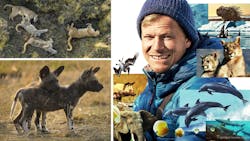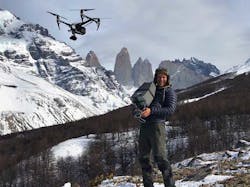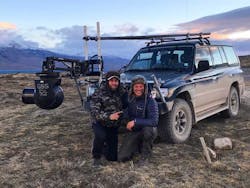The Tech Behind Bertie Gregory’s “Animals Up Close”
What you’ll learn
- Who is Bertie Gregory?
- Gregory’s previous award-winning shows and movies.
- The drone and camera technology used in his cinematic endeavors.
Wildlife filmmaker and NatGeo explorer Bertie Gregory is set to launch his new nature series “Animals Up Close with Bertie Gregory” on Disney+ on September 13, 2023. The series highlights the secret lives of animals across the globe, spanning all types of ecosystems, terrain, and aquatic locations to deliver stunning imagery and HD video of animals in their natural environments.
Bertie began his career at National Geographic in 2014 as an assistant to photographer Steve Winter, whose career spans two decades and specializes in wildlife, particularly with large cats. After that time, Bertie went on to produce and host six acclaimed projects, including “Leopards at the Door,” “Jaguar vs. Croc,” “Wild_Life,” “Resurrection Island,” and “The Big Freeze.”
To his credit, Bertie won the best television host at the Jackson Wild Awards in 2019 for “Resurrection Island” and became one of BAFTA’s youngest cinematography winners for his work on “Seven Worlds, One Planet.” While the HD video and images are the stars of each series, the work of getting those fantastic scenes is remarkable and a challenging endeavor on its own.
Being muddy, wet, and cold; climbing trees; going up mountains; and diving under the ice is part of the job, and that’s just getting to the location. Hunkering down in those environments, waiting for the perfect time while dealing with, or rather trying to ignore, the local insect populations is another. But without that technology, the cameras, drones, and robotic systems, none of it would be possible.
Drone-Driven Dramatics
Many industries have taken advantage of drones for specific applications. They provide unique views, maneuver into areas difficult for humans, and can be outfitted with several different hardware options. In his case, Bertie uses them to garner powerful HD images and video, and in some cases, without disturbing the environment or the animals being filmed.
He employs a number of different drones depending on the application, with most from DJI (Fig. 1). His top performer is the Mavic 3 Pro, a powerful drone with a three-axis gimbal that comes outfitted with a triple-camera system, including a Hasselblad and dual tele-cameras. Bertie also uses DJI’s Inspire 2 professional drone, which is outfitted with the CineCore 2.1 image-processing system. It’s capable of recording video in 6K at 4.44-Gb/s CinemaDNG 1, 5.2K at 2.08-Gb/s Apple ProRes 2, and H.265/H.264 at 100 Mb/s.
“Drones used to be a tool that was only useful because of their very short battery life and limitation on cameras. And it's just a tool to get kind of pretty landscape aerials,” said Gregory in a recent interview with Endeavor. “Whereas now, because of the increased battery life, increased range, and increased gimbal technology, means we can put in longer zoom lenses on them suddenly for filming wildlife. That's such an amazing tool, you know, we can film things that we thought we understood.”
Drones also provide Bertie with unique angles while filming, meaning instead of one camera to garner video, three can be used simultaneously to capture animals up close at ground levels and obtain aerial shots for a bigger picture.
Gyro-Stabilized Gimbal System
The drones can also be outfitted with many specialized cameras, which Gregory mounts to a gyro-stabilized gimbal system, or GSS (Fig. 2). It’s similar to what the military uses on helicopters and fixed-wing aircraft to maintain stabilization and precision tracking. The ball houses 50- to 1500-mm lenses to grab up-close stable HD video without vibration or other interference.
He’s also mounted enhanced thermal imaging and night vision systems, like those equipped on Apache attack helicopters, to capture unique video of animals in low-light and dark conditions. Gregory highlights its capabilities in the field by focusing on elephants in the dark, where you can see the blood vessels in the ears, as they’re the primary component of how the massive creatures cool themselves.
The drones, trail-cams, and specialized cameras are just a few of the components needed to create those award-winning shows and films. Other hardware also comes into play, including the many batteries needed for power and all of the media storage platforms that hold those HD videos and images. These need to be carried or transported to those locations for use, which then get delivered to technicians who archive the material and to the editors who process, splice, and meld them into what we see at home.
A fantastic amount of technology goes into Gregory’s cinematic endeavors, allowing viewers to see what’s never been captured before. And it will be on full display in his soon-to-air “Animals Up Close” series.
About the Author
Cabe Atwell
Technology Editor, Electronic Design
Cabe is a Technology Editor for Electronic Design.
Engineer, Machinist, Maker, Writer. A graduate Electrical Engineer actively plying his expertise in the industry and at his company, Gunhead. When not designing/building, he creates a steady torrent of projects and content in the media world. Many of his projects and articles are online at element14 & SolidSmack, industry-focused work at EETimes & EDN, and offbeat articles at Make Magazine. Currently, you can find him hosting webinars and contributing to Electronic Design and Machine Design.
Cabe is an electrical engineer, design consultant and author with 25 years’ experience. His most recent book is “Essential 555 IC: Design, Configure, and Create Clever Circuits”
Cabe writes the Engineering on Friday blog on Electronic Design.



